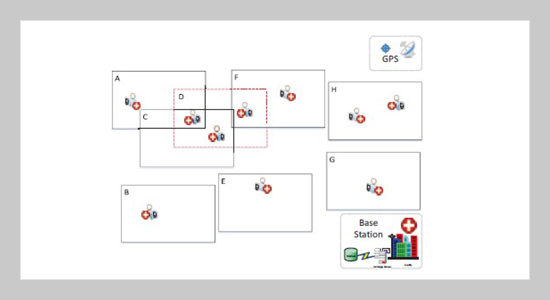REFERENCES
- [1] Lee, S., and A. Holzinger, (2016) Knowledge discovery from complex high dimensional data, Michaelis S., Piatkowski N., Stolpe M. (ed.) Solving Large Scale Learning Tasks, Challenges and Algorithms, Lecture Notes in Computer Science, Springer, Cham, 9580, 148-167. doi: https://doi.org/10.1007/978-3-319-41706-6_7.
- [2] Yeh, T., J. J. Lee, and T. Darrell, (2009) Fast concurrent object localization and recognition, Proc. of 2009 IEEE Computer Society Conference on Computer Vision and Pattern Recognition (CVPR), 280-287. doi: https://doi.org/10.1109/cvprw.2009.5206805
- [3] Lettich, F., S. Orlando, and C. Silvestri, (2015) Processing streams of spatial k-nn queries and position updates on manycore gpus, Proc. of 23rd ACM SIGSPATIAL 2015, Washington, USA. doi: https://doi.org/10.1145/2820783.2820803
- [4] Hassan, M. M., S. Huda, M. Z. Uddin, A. Almogren, and M. Alrubaian, (2018) “Human activity recognition from body sensor da-ta using deep learning,” J Med Syst 42 (99). doi: https://doi.org/10.1007/s10916-018-0948-z.
- [5] Gonzalez, M. C., C. A. Hidalgo, and A.-L. Barabasi, (2008) “Understanding individual human mobility patterns,” Nature 453, 779-782. doi: https://doi.org/10.1038/nature06958.
- [6] Beltrame, T., R. Amelard, A. Wong, and R. L. Hughson, (2018) “Extracting aerobic system dynamics during unsupervised activities of daily living using wearable sensor machine learning models,” Journal of Applied Physiology 124, 473-481. doi: https://doi.org/10.1152/japplphysiol.00299.2017.
- [7] Nogueira, P., J. Urbano, L. P. Reis, H. L. Cardoso, D. C. Silva, A. P. Rocha, and et al., (2018) “A review of commercial and medical grade physiological monitoring devices for biofeedback-assisted quality of life improvement studies,” J Med Syst 42 (113). doi: https://doi.org/10.1007/s10916-018-0946-1
- [8] Esposito, M., A. Minutolo, R. Megna, M. Forastiere, M. Magliulo, and G. De Pietro, (2018) “A smart mobile, self-configuring, context-aware architecture for personal health monitoring,” Engineering Applications of Artificial Intelligence 67, 136-156. doi: https://doi.org/10.1016/j.engappai.2017.09.019
- [9] Or, C., E. Tong, J. Tan, and S. Chan, (2018) “Exploring factors affecting voluntary adoption of electronic medical records among physicians and clinical assistants of small or solo private general practice clinics,” J Med Syst 42 (121). doi: https://doi.org/10.1007/s10916-018-0971-0
- [10] Singh, D., E. Merdivan, I. Psychoula, J. Kropf, S. Hanke, M. Geist, and et al., (2017) Human activity recognition using recurrent neural networks, Holzinger A., Kieseberg P., Tjoa A., Weippl E. (eds) Machine Learning and Knowledge Extraction (CD-MAKE 2017), Lecture Notes in Computer Science, Springer, Cham, 10410, 267-274. doi: https://doi.org/10.1007/978-3-319-66808-6_18
- [11] Wu, R., G. Luo, J. Shao, L. Tian, and C. Peng, (2018) “Location prediction on trajectory data: a review,” Big Data Mining and Analytics 1 (2), 108-127. doi: https://doi.org/10.26599/BDMA.2018.9020010
- [12] Yu, Z, (2015) “Trajectory data mining: An overview,” ACM Transactions on Intelligent Systems and Technology 6 (3). doi: https://doi.org/10.1145/2743025
- [13] Amagata, D., and T. Hara, (2017) “A general framework for maxrs and maxcrs monitoring in spatial data streams,” ACM Trans. Spatial Algorithms Syst. 3 (1). doi: https://doi.org/10.1145/3080554
- [14] Adu-Gyamfi, D., F. Zhou, F. Zhang, K. P. Kibiwott, and V. Dela Tattrah, (2019) Real-time Monitoring of Mobile User using Trajectory Data Mining, 2019 IEEE International Conference on Electrical, Computer and Communication Technologies (ICECCT), Coimbatore, India, 1-8. doi: https://doi.org/10.1109/ICECCT.2019.8869336
- [15] Zheng, Y., X. Xie, and W.-Y. Ma, (2010) “GeoLife: A collaborative social networking service among user, location and trajectory,” IEEE Data(base) Engineering Bulletin 33, 32-39.
- [16] Bakalov, P., and V. J. Tsotras, (2008) Continuous spatiotemporal trajectory joins, Nittel S., Labrinidis A., Stefanidis A. (eds) GeoSensor Networks (GSN 2006), Lecture Notes in Computer Science, Springer, Berlin, Heidelberg, 4540, 109-128. doi: https://doi.org/10.1007/978-3-540-79996-2_7
- [17] Li, F., X. Long, S. Du, J. Zhang, Z. Liu, M. Li, and et al., (2015) Analyzing campus mobility patterns of college students by using gps trajectory data and graph-based approach, Proc. of 2015 23rd International Conference on Geoinformatics. doi: https://doi.org/10.1109/GEOINFORMATICS.2015.7378667
- [18] Ebadi, N., J. E. Kang, and S. Hasan, (2017) “Constructing activity-mobility trajectories of college students based on smart card transaction data,” International Journal of Transportation Science and Technology 6 (4) 316-329. doi: https://doi.org/10.1016/j.ijtst.2017.08.003
- [19] Cho, E., S. A. Myers, and J. Leskovec, (2011) Friendship and mobility: user movement in location-based social networks, Proc. of 17th ACM SIGKDD International Conference on Knowledge Discovery and Data Mining, 1082-1090. doi: https://doi.org/10.1145/2020408.2020579
















